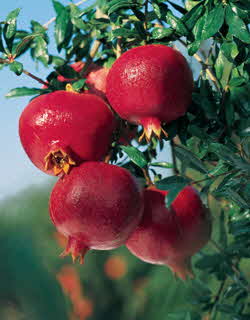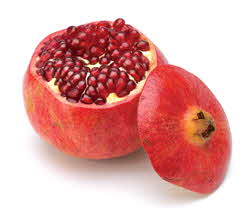Home | FOOD ARTICLES | Food Trivia | Today_in_Food_History | Food_History_Timeline | Recipes | Cooking_Tips | Food_Videos | Food_Quotes | Who’s_Who | Culinary_Schools_&_Tours | Food_Trivia_Quizzes | Food_Poems | Free_Magazines | Food_Festivals_and_Events
Food Articles, News & Features Section
FREE Magazines
and other Publications
Free Professional and Technical Research, White Papers, Case Studies, Magazines, and eBooks
The Wonderful Variety of Pomegranate
See also: Pomegranate History; Pomegranate Tips & Usage; Pomegranate Trivia
The Wonderful Pomegranate
The Wonderful variety of pomegranate is known for its sweet taste, plentiful juice and health benefits that may help with heart disease, cancer and problems associated with aging. It’s loaded with antioxidants, vitamins, potassium, folic acid and iron. It’s also the only variety of pomegranate grown exclusively by POM Wonderful.
Grown in the heart of the San Joaquin Valley, the Wonderful pomegranate thrives in the hot days and cool nights of Central California. Every spring in POM Wonderful’s orchards, the majestic pomegranate begins its life cycle, transforming from a delicately fragrant blossom into a beautiful crimson orb containing a treasure of ruby-like arils inside.
Blossom
In May, the red petals of the pomegranate tree, crumpled from their confinement in the bud, exude a delicate fragrance that attracts bees to pollinate the flowers. So begins the remarkable change from flower to fruit.

Maturation
At summer’s end, the petals from each pollinated pomegranate blossom wither and fall, revealing a royal crown that adorns the top of the forming fruit. After a burst of growth, the pomegranate’s shape begins to emerge. Hot, sunny days will ripen the inside, while cool nights will cause the rind to deepen from green to red. After several more weeks, the pomegranate will acquire its signature crimson color and sweet flavor.
Harvest
In October, POM Wonderful’s orchards are bursting with thousands of acres of ripe pomegranates. The pericarp, or rind, that surrounds the fruit is now a tough and leathery barrier, smooth yet firm to the touch, that protects the magnificent ruby-colored interior. The pomegranate’s many chambers are filled with nutrient-rich arils, each containing sweet juice and a small edible seed.
Season
The Wonderful pomegranate season lasts from October through January. The Wonderful variety of pomegranate is a fall fruit and its arrival in stores signifies that the holiday season is upon us. To celebrate the pomegranate’s arrival, November is National Pomegranate Month.
Parts of the Pomegranate
• Aril – The botanical term for a seed surrounded by a juice sac.
• Albedo – The white, fleshy substance directly under the skin of a pomegranate.
• Membrane – The see-through yellow material surrounding the pomegranate arils. The membrane is bitter and not recommended for consumption.
• Rind – The outer peel or husk of a pomegranate. Much of the antioxidant content of the juice comes from crushing the whole fruit, as the rind contains a high amount of these beneficial phytonutrients.
How to Choose a Pomegranate
For eating or juicing, select pomegranates by weight, not by color. Pomegranates are only picked when they are perfectly ripe on the inside. The outside of a ripe pomegranate can vary from pink to a deep ruby red. Keep in mind that the heavier the pomegranates are, the more juice they contain.
For decorating, select pomegranates by color, size and general appearance.
How to Store a Pomegranate
Unopened pomegranates can last up to one month on the counter or two months in the refrigerator. Fresh arils can last two weeks in the refrigerator in a sealed plastic container and frozen arils can last for many months in the freezer.
To freeze pomegranate arils, spread them in a single layer on a baking sheet lined with wax paper. Place in a freezer for two hours or until frozen, and transfer frozen arils to a resealable plastic bag or container. Frozen arils can be enjoyed well after the season has ended.

How to Open a Pomegranate
Pomegranates may seem intimidating, but they are simple to open. This no-mess procedure for opening pomegranates has three simple steps:
1. Cut the crown end off the pomegranate and lightly score the skin from top to bottom in quarters.
2. Immerse the pomegranate in a bowl of cool water and break open the fruit under water to free the arils (they will sink to the bottom of the bowl and the membrane will float to the top). Discard the rind and membrane.
3. Sieve the remaining liquid and put the arils to one side to dry.
How to Enjoy a Pomegranate
The pomegranate is a fruit with many uses. Pomegranate arils are perfect for tossing in salads, stirring in yogurt, sprinkling on cereal, incorporating in quick breads and cookies, or enjoying on their own as a healthy snack. In addition to eating, pomegranates are also delicious when squeezed to make fresh juice. Pomegranate arils and juice are delicious and healthy additions to food and drink recipes. Whole pomegranates also make beautiful holiday decorations.
HEALTH BENEFITS
Throughout the world, the pomegranate has been associated with good health. Preparations using parts of the pomegranate (the juice, arils, husk and bark) have, over centuries, been used to treat a variety of conditions. Hippocrates used pomegranates for eye infections and to aid digestion; Roman author and scientist Pliny the Elder prescribed pomegranate juice for pregnant women suffering from morning sickness – along with 25 other remedies; and in the 12th century, Dioscorides cited pomegranates as a treatment for ulcers and other maladies. Today, scientists are researching the powerful health benefits of the pomegranate. Pomegranates contain beneficial potassium and fiber. Potassium helps regulate blood pressure and maintain strong bones. Fiber helps maintain digestive regularity and may reduce LDL cholesterol, which may help lower the risk of heart disease.
Antioxidants
The Wonderful variety of pomegranate also contains some of nature’s most effective antioxidants, called polyphenols. These powerful antioxidants are important in the daily diet. Those in pomegranate juice include punicalagin, a polyphenol unique to pomegranates; anthocyanins, which are responsible for giving pomegranate juice its rich red color; and resveratrol, the main active compound in red wine.
What They Do For You
Antioxidants help protect the body against “free radicals” – molecules that cause damage to our bodies over time. Free-radical damage is a major factor in aging and chronic diseases such as heart disease and cancer. Medical research has shown that a daily amount of polyphenol antioxidants may help promote a healthy heart and prostate by minimizing factors that lead to atherosclerosis, or plaque in the arteries, and prostate cancer. Atherosclerosis is a major cause of heart disease, America’s #1 killer.
POM Wonderful: www.pomwonderful.com
RELATED ARTICLES
Please feel free to link to any pages of FoodReference.com from your website.
For permission to use any of this content please E-mail: james@foodreference.com
All contents are copyright © 1990 - 2025 James T. Ehler and www.FoodReference.com unless otherwise noted. All rights reserved.
You may copy and use portions of this website for non-commercial, personal use only.
Any other use of these materials without prior written authorization is not very nice and violates the copyright.
Please take the time to request permission.

